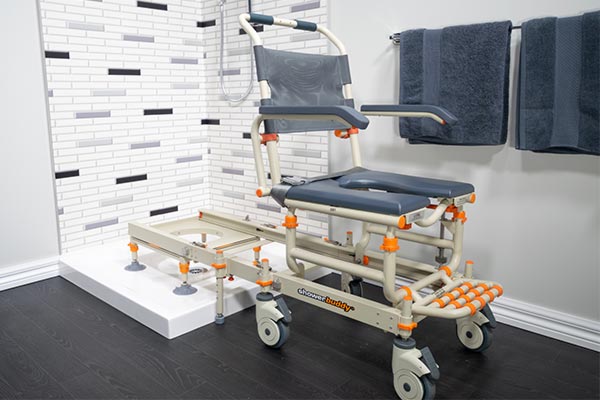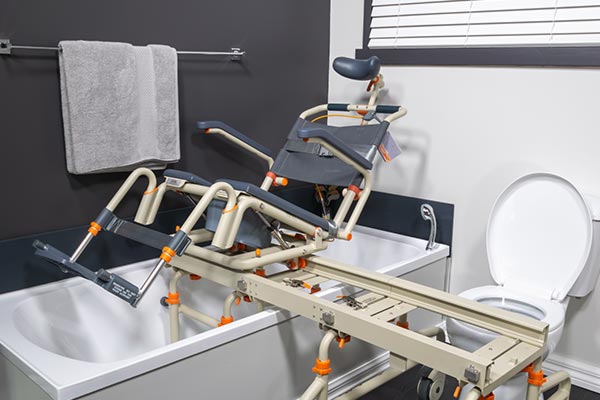-
Transferring into a bathtub: or shower
This is one of the riskier parts of the day for someone with a mobility impairment. It’s also risky to their support person, be it a family member or professional at home carer. This is because there’s a significant movement of weight distribution in a wet, slippery environment. Add hard bathroom fixtures into the mix and suddenly what should be a relaxing time of day becomes fraught with risks and worry.
Luckily systems exist to support safe, lift-free transferring. Combined with proper OT-approved bathroom plans, getting into and out of the shower can be quick and safe.
In this guide we’ll take a closer look at the transfer process for someone with a mobility impairment, providing some insights around how shower chairs play an important part in facilitating a good transfer experience.
Is a transfer shower bench really the best option?
If you’re in the middle of an online research into shower transfer benches, you’ll have come across bath or shower ‘transfer benches’. Unfortunately many of these products are fairly overpriced for what they offer – a static plastic platform on which individuals need to be moved across in order to get into the bath. These ‘benches’ seek to solve this important matter of transferring in and out of the bath or shower, but fail to take away one of the riskiest elements: manual effort.
Up there with the most common injuries sustained by aged and in home carers are associated with lifting and shifting. Our bodies and muscles are designed to move in a certain way. When irregular stressors get placed on us, such as trying to support a human body across a bath edge, this can strain muscle groups not designed to carry the weight. When a family member or carer is injured this doesn’t just affect them, but the individual they’ve committed to helping each day.
A transfer bench may be sufficient for someone who is capable of using upper body strength to shuffle across, but even this use case comes with risks such as poor positioning causing the bench to tip over.
So is a transfer bench the best option? In most cases – no.
-
![]()
MODEL SB1: The modular chair and track system is designed to clear raised shower tray edges. Once the chair is locked in the shower position the front bridge tracks can be remove to aid carer access.
-
![]()
Your OT: Plan
-
Crafting a good OT plan for daily bathing
No assistive technology can really add value without the right plan in place. An occupational therapist will need to design a bathroom routine that makes sense to the client and their family. This means planning out typical functions and how they’ll be executed. The transfer into the bath is usually the most challenging of these to plan.
When planning for transfers, OTs will look at a number of factors including:
- The mobility impaired individual’s own capability to move and assist with their transfer.
- The distance between the outside and inside of the shower or bath (i.e. how far do they need to be transferred?)
- Who is available and willing to assist each day (more than one option is preferred in case of emergencies or to spread the load).
- What type of bathroom configuration does the individual have?
- What supports do they need in place to stay secure during transfer (e.g. seatbelts)?
These are just a sample of an extensive assessment an OT might do when working out the best way to handle daily bathroom transfers. If you’re working with an OT as the client or family of the client, chat with them directly about the assessment in more detail.
-
Checks &: Testing
-
Checking and testing all equipment before starting
Before assistive technology is used for the first time, it should be tested after installation by a carer, OT, or PT. They can ensure that functionally the equipment is performing the transfer properly, whether this is a transfer chair system like Showerbuddy, a hoist or any other equipment deemed appropriate.
Testing is crucial to do thoroughly, to reduce the chances of equipment failure in real use. Good quality systems will come with guidelines around installation and testing and/or good customer support to help the OT ensure things are working properly.
Reducing heavy or awkward movements
If you’re someone who is involved with a person’s daily bathroom plan, such as a spouse or other family member, you’ll want to reduce or eliminate awkward carrying movements. Sustained or significant carrying loads can pull or tear muscles, even on the strongest of bodies.
Transferring someone into a shower chair should be done with the aid of equipment in an ideal scenario. If you have a shower transfer system like Showerbuddy, the initial mounting onto the chair may be better to undertake outside the bathroom in a dry, open space like a bedroom or living room. You may even have other assistive technologies like a hoist that supports the majority of the person’s weight as they get into the chair.
Once in the bathroom however, any transferring should be reduced or eliminated entirely. This is possible with an all in one shower transfer and commode system or if you go the remodelling route, with other technologies.
-
![]()
Support: features
-
Neck rests and additional body support
Transferring a user with little to no mobility may require additional equipment to help the process be completed safely. These supports include:
- Neck rest to keep the head in place
- Seat belt to help stabilise torso and remain in the chair during transfer
- Tilting function of the chair to clear legs over the side of a bathtub
- Feet rests
- Alternative backrest sizes and materials to offer a more snug fit or better stability.
Any shower chair purchase made for someone with a disability should come from requirements as assessed by a qualified occupational therapist. This helps ensure the system is totally fit for their requirements.
Commode functionality within the same transfer equipment – why this helps
A commode opening within a shower chair reduces a slippery dangerous transfer after a shower. It also provides users with a quick option in times where getting to the toilet is not possible in a timely fashion. By choosing a system that has commode support, the bathroom routine does not have to include an extra transfer.
Make the transfers easy with a sliding bridge system
The idea behind Showerbuddy’s transfer system is based on making the entry and exit from a bath or shower quick and secure. When opting for a system like this, the user will be shifted across a bridge while seated in the shower chair they’ll bathe in. They will end up on an in-tub or shower base that’s fixed securely to surfaces. The bridge can then be quickly disconnected, allowing ease of access by the carer.
Why a bridge system makes sense:
- There’s no lifting at all once they’re in the chair – which can happen outside of the bathroom.
- It’s smooth and quick to move someone into the shower or bath.
- It can all be packed away and set up elsewhere.
- The chair can be used both inside and outside the shower – it’s just the bottom half that changes (base vs. wheels).
- It doesn’t need any permanent remodelling.
-
Safe: bathroom transfers
-
Keeping a clear path between the door and shower
Leading up to a transfer is positioning the user right up to the side of the shower or bath unit. When bathrooms are wet or cluttered, there’s more risk of equipment being stuck and causing accidents. For any bathroom that’s used by a mobility impaired person, a clean clear space is always recommended.
This may require other members of the household to migrate some of their morning routine back into their bedroom to clear away things like makeup shelves and decorative towel storage. This also means that bathmats and scales should be carefully put away before a shower transfer needs to take place. If in doubt, move it out.
Some households may decide to move these items and storage solutions onto the walls, which frees up floor space without greatly affecting anyone’s bathroom ritual!
Avoiding in-bathroom swapping between equipment
It’s the moving between equipment where so many of the accidents and injuries can happen. Even swapping between a wheelchair and toilet riser can prove dangerous. For someone who has a significant disability and is unable to support their own bodyweight, lifting and shifting should be totally eliminated if possible.
Of course there are times where lifting is required, such as when the disabled individual ends up in an uncomfortable body position. But a bathroom routine that demands manual carrying from one piece of equipment to the next is putting unnecessary risk on all involved.
Learn more about Showerbuddy’s Transfer range offering: incredible comfort and ease
If you’re interested in finding out what Showerbuddy can offer with bathroom transfers, head over to our Transfer Range section where you’ll learn about our game-changing SB1 ShowerBuddy and SB2/T TubBuddy models.




